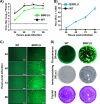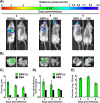A Novel Fluorescent and Bioluminescent Bireporter Influenza A Virus To Evaluate Viral Infections
- PMID: 30867298
- PMCID: PMC6498038
- DOI: 10.1128/JVI.00032-19
A Novel Fluorescent and Bioluminescent Bireporter Influenza A Virus To Evaluate Viral Infections
Abstract
Studying influenza A virus (IAV) requires the use of secondary approaches to detect the presence of virus in infected cells. To overcome this problem, we and others have generated recombinant IAV expressing fluorescent or luciferase reporter genes. These foreign reporter genes can be used as valid surrogates to track the presence of virus. However, the limited capacity for incorporating foreign sequences in the viral genome forced researchers to select a fluorescent or a luciferase reporter gene, depending on the type of study. To circumvent this limitation, we engineered a novel recombinant replication-competent bireporter IAV (BIRFLU) expressing both fluorescent and luciferase reporter genes. In cultured cells, BIRFLU displayed growth kinetics comparable to those of wild-type (WT) virus and was used to screen neutralizing antibodies or compounds with antiviral activity. The expression of two reporter genes allows monitoring of viral inhibition by fluorescence or bioluminescence, overcoming the limitations associated with the use of one reporter gene as a readout. In vivo, BIRFLU effectively infected mice, and both reporter genes were detected using in vivo imaging systems (IVIS). The ability to generate recombinant IAV harboring multiple foreign genes opens unique possibilities for studying virus-host interactions and for using IAV in high-throughput screenings (HTS) to identify novel antivirals that can be incorporated into the therapeutic armamentarium to control IAV infections. Moreover, the ability to genetically manipulate the viral genome to express two foreign genes offers the possibility of developing novel influenza vaccines and the feasibility for using recombinant IAV as vaccine vectors to treat other pathogen infections.IMPORTANCE Influenza A virus (IAV) causes a human respiratory disease that is associated with significant health and economic consequences. In recent years, the use of replication-competent IAV expressing an easily traceable fluorescent or luciferase reporter protein has significantly contributed to progress in influenza research. However, researchers have been forced to select a fluorescent or a luciferase reporter gene due to the restricted capacity of the influenza viral genome for including foreign sequences. To overcome this limitation, we generated, for the first time, a recombinant replication-competent bireporter IAV (BIRFLU) that stably expresses two reporter genes (one fluorescent and one luciferase) to track IAV infections in vitro and in vivo The combination of cutting-edge techniques from molecular biology, animal research, and imaging technologies brings researchers the unique opportunity to use this new generation of reporter-expressing IAV to study viral infection dynamics in both cultured cells and animal models of viral infection.
Keywords: Nano luciferase; Venus fluorescence; bioluminescence; fluorescence; in vivo expression technology; influenza; reporter genes.
Copyright © 2019 American Society for Microbiology.
Figures










Similar articles
-
Replication-Competent ΔNS1 Influenza A Viruses Expressing Reporter Genes.Viruses. 2021 Apr 17;13(4):698. doi: 10.3390/v13040698. Viruses. 2021. PMID: 33920517 Free PMC article.
-
A Luciferase-fluorescent Reporter Influenza Virus for Live Imaging and Quantification of Viral Infection.J Vis Exp. 2019 Aug 14;(150). doi: 10.3791/59890. J Vis Exp. 2019. PMID: 31475986
-
Optimisations and Challenges Involved in the Creation of Various Bioluminescent and Fluorescent Influenza A Virus Strains for In Vitro and In Vivo Applications.PLoS One. 2015 Aug 4;10(8):e0133888. doi: 10.1371/journal.pone.0133888. eCollection 2015. PLoS One. 2015. PMID: 26241861 Free PMC article.
-
Replication-Competent Influenza A Viruses Expressing Reporter Genes.Viruses. 2016 Jun 23;8(7):179. doi: 10.3390/v8070179. Viruses. 2016. PMID: 27347991 Free PMC article. Review.
-
Recombinant Influenza A Viruses Expressing Reporter Genes from the Viral NS Segment.Int J Mol Sci. 2024 Oct 1;25(19):10584. doi: 10.3390/ijms251910584. Int J Mol Sci. 2024. PMID: 39408912 Free PMC article. Review.
Cited by
-
Coelenterazine-Dependent Luciferases as a Powerful Analytical Tool for Research and Biomedical Applications.Int J Mol Sci. 2020 Oct 10;21(20):7465. doi: 10.3390/ijms21207465. Int J Mol Sci. 2020. PMID: 33050422 Free PMC article. Review.
-
Bioluminescent and Fluorescent Reporter-Expressing Recombinant SARS-CoV-2.Methods Mol Biol. 2022;2524:235-248. doi: 10.1007/978-1-0716-2453-1_18. Methods Mol Biol. 2022. PMID: 35821476 Free PMC article.
-
Deep mutationally scanned CHIKV E3/E2 virus library maps viral amino acid preferences and predicts viral escape mutants of neutralizing CHIKV antibodies.J Virol. 2025 Apr 15;99(4):e0008125. doi: 10.1128/jvi.00081-25. Epub 2025 Mar 27. J Virol. 2025. PMID: 40145739 Free PMC article.
-
Replication-Competent ΔNS1 Influenza A Viruses Expressing Reporter Genes.Viruses. 2021 Apr 17;13(4):698. doi: 10.3390/v13040698. Viruses. 2021. PMID: 33920517 Free PMC article.
-
Novel replication-competent reporter-expressing Rift Valley fever viruses for molecular studies.J Virol. 2025 Jan 31;99(1):e0178224. doi: 10.1128/jvi.01782-24. Epub 2024 Dec 12. J Virol. 2025. PMID: 39665546 Free PMC article.
References
-
- Palese PM. 2007. Orthomyxoviridae: the viruses, and their replication In Knipe DM, Howley PM, Griffin DE, Lamb RA, Martin MA, Roizman B, Straus SE (ed), Fields virology, 5th ed Lippincott Williams & Wilkins, Philadelphia, PA.
-
- Munster VJ, Baas C, Lexmond P, Waldenstrom J, Wallensten A, Fransson T, Rimmelzwaan GF, Beyer WE, Schutten M, Olsen B, Osterhaus AD, Fouchier RA. 2007. Spatial, temporal, and species variation in prevalence of influenza A viruses in wild migratory birds. PLoS Pathog 3:e61. doi:10.1371/journal.ppat.0030061. - DOI - PMC - PubMed
Publication types
MeSH terms
Substances
Grants and funding
LinkOut - more resources
Full Text Sources

